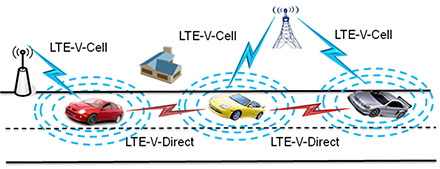|
This article provides an overview of the Long-Term Evolution – Vehicle (LTE-V) standard supporting sidelink or vehicle-to-vehicle (V2V) communications using LTE’s direct interface named PC5 in LTE. We review the physical layer changes introduced under Release 14 for LTE-V, its communication modes 3 and 4, and the LTE-V evolutions under discussion in Release 15 to support fifth-generation (5G) vehicle-to-everything (V2X) communications and autonomous vehicles’ applications.

Modes 3 and 4 support direct V2V communications but differ on how they allocate the radio resources. Resources are allocated by the cellular network under mode 3. Mode 4 does not require cellular coverage, and vehicles autonomously select their radio resources using a distributed scheduling scheme supported by congestion control mechanisms.
Mode 4 is considered the baseline mode and represents an alternative to 802.11p or dedicated short range communications (DSRC). In this context, this article also presents a detailed analysis of the performance of LTE-V sidelink mode 4, and proposes a modification to its distributed scheduling.
V2X communications will enable the exchange of information between vehicles (V2V) and between vehicles and other nodes (infrastructure and pedestrians). This exchange will provide vehicles with a more accurate knowledge of their surrounding environment that can improve traffic safety [1].
Efforts have been made in recent years to develop V2X communications using IEEE 802.11p [18]. However, 802.11p uses a carrier sense multiple access with collision avoidance medium-access scheme, and can face some challenges when guaranteeing strict reliability levels and ensuring the network’s scalability as the load increases [2].
As an alternative, the Third Generation Partnership Project (3GPP) published the first version of Release 14 in September 2016, which includes support for V2X communications [3]. The standard is commonly referred to as LTE-V, LTE-V2X, or cellular V2X. The LTE-V physical layer improves the link budget with regard to 802.11p. In addition, LTE-V can increase the reliability, under certain conditions, by adding a redundant transmission per packet.
The LTE-V standard includes two radio interfaces. The cellular interface (named Uu) supports vehicle-to-infrastructure communications, while the PC5 interface supports V2V communications based on direct LTE sidelink. LTE sidelink (or device-to-device communication) was introduced for the first time under Release 12 for public safety, and includes two modes of operation: mode 1 and mode 2. Both modes were designed with the objective of prolonging the battery lifetime of mobile devices at the cost of increasing the latency.
Connected vehicles require highly reliable and low-latent V2X communications; therefore, modes 1 and 2 are not suitable for vehicular applications.
Release 14 introduces two new communication modes (modes 3 and 4) specifically designed for V2V communications. In mode 3, the cellular network selects and manages the radio resources used by vehicles for their direct V2V communications.
In mode 4, vehicles autonomously select the radio resources for their direct V2V communications. In contrast, mode 4 can operate without cellular coverage, and is therefore considered the baseline V2V mode since safety applications cannot depend on the availability of cellular coverage.
Mode 4 includes a distributed scheduling scheme for vehicles to select their radio resources and includes the support for distributed congestion control.
Full article: IEEE Vehicular Technology Magazine, Volume 12, Number 4, December 2017 |